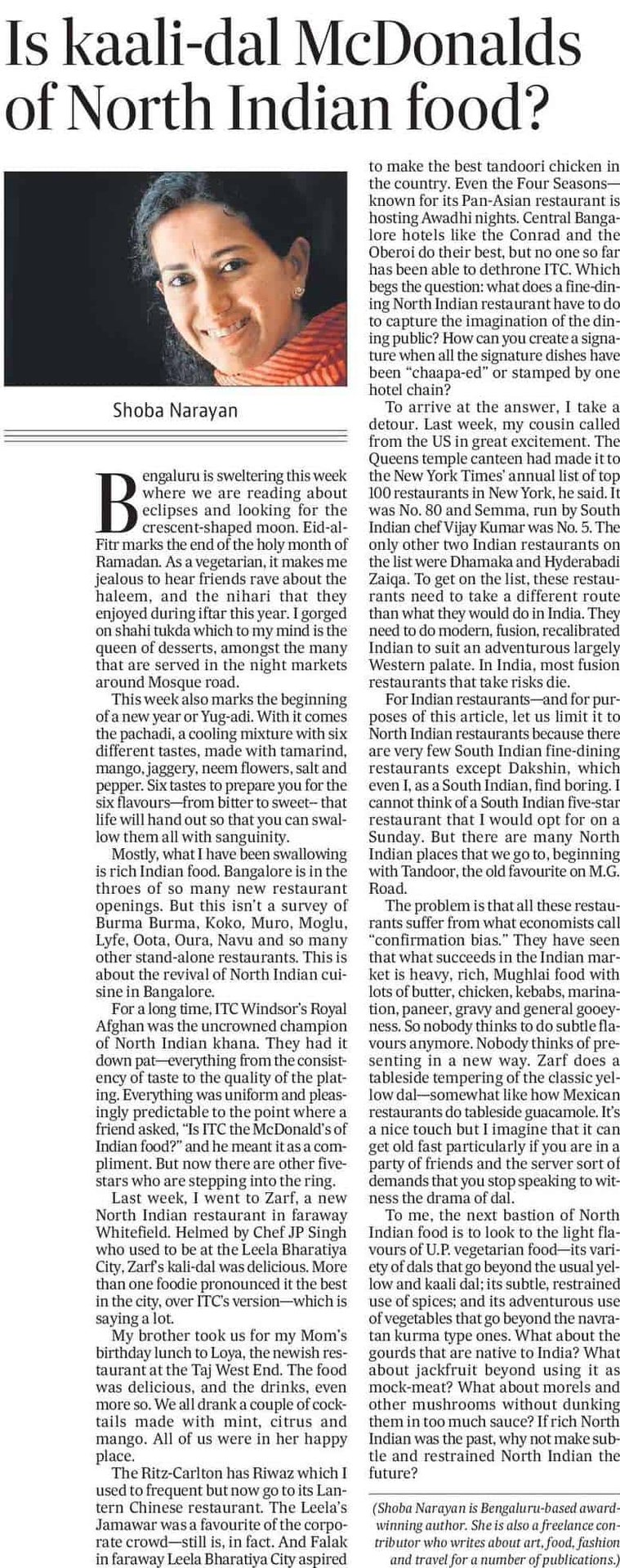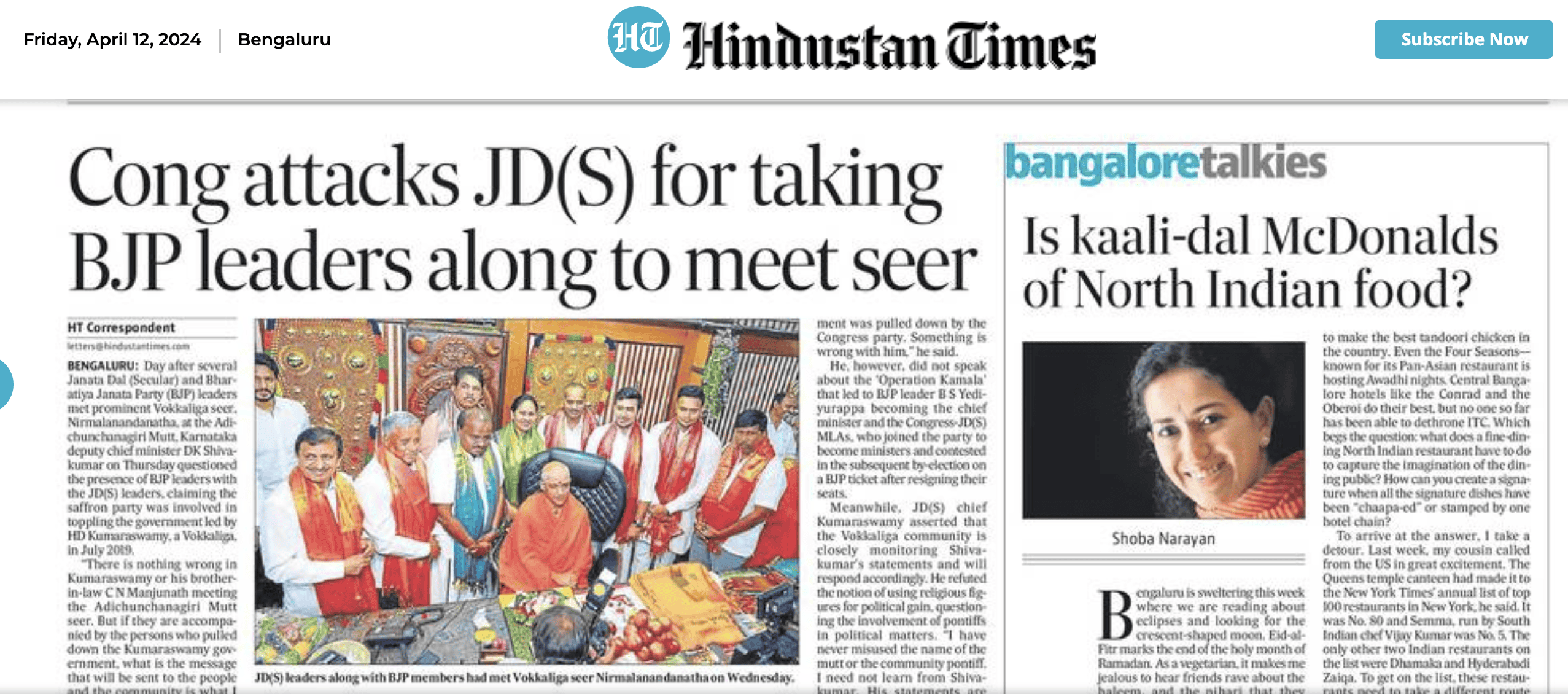Bangalore is sweltering this week where we are reading about eclipses and looking for the crescent-shaped moon. Eid-al-Fitr marks the end of the holy month of Ramadan. As a vegetarian, it makes me jealous to hear friends rave about the haleem, and the nihari that they enjoyed during iftar this year. I gorged on shahi tukda which to my mind is the queen of desserts, amongst the many that are served in the night markets around Mosque road.
This week also marks the beginning of a new year or Yug-adi. With it comes the pachadi, a cooling mixture with six different tastes, made with tamarind, mango, jaggery, neem flowers, salt and pepper. Six tastes to prepare you for the six flavours—from bitter to sweet– that life will hand out so that you can swallow them all with sanguinity.
Mostly, what I have been swallowing is rich Indian food. Bangalore is in the throes of so many new restaurant openings. But this isn’t a survey of Burma Burma, Koko, Muro, Moglu, Lyfe, Oota, Oura, Navu and so many other stand-alone restaurants. This is about the revival of North Indian cuisine in Bangalore.
For a long time, ITC Windsor’s Royal Afghan was the uncrowned champion of North Indian khana. They had it down pat—everything from the consistency of taste to the quality of the plating. Everything was uniform and pleasingly predictable to the point where a friend asked, “Is ITC the McDonald’s of Indian food?” and he meant it as a compliment. But now there are other five-stars who are stepping into the ring.
Last week, I went to Zarf, a new North Indian restaurant in faraway Whitefield. Helmed by Chef J.P. Singh who used to be at the Leela Bharatiya City, Zarf’s kali-dal was delicious. More than one foodie pronounced it the best in the city, over ITC’s version—which is saying a lot.
My brother took us for my Mom’s birthday lunch to Loya, the newish restaurant at the Taj West End. The food was delicious, and the drinks, even more so. We all drank a couple of cocktails made with mint, citrus and mango. All of us were in her happy place. The Ritz-Carlton has Riwaz which I used to frequent but now go to its Lantern Chinese restaurant. The Leela’s Jamawar was a favourite of the corporate crowd—still is, in fact. And Falak in faraway Leela Bharatiya City aspired to make the best tandoori chicken in the country. Even the Four Seasons—known for its Pan-Asian restaurant is hosting Awadhi nights. Central Bangalore hotels like the Conrad and the Oberoi do their best, but no one so far has been able to dethrone ITC. Which begs the question: what does a fine-dining North Indian restaurant have to do to capture the imagination of the dining public? How can you create a signature when all the signature dishes have been “chaapa-ed” or stamped by one hotel chain?
To arrive at the answer, I take a detour. Last week, my cousin called from the US in great excitement. The Queens temple canteen had made it to the New York Times’ annual list of top 100 restaurants in New York, he said. It was No. 80 and Semma, run by South Indian chef Vijay Kumar was No. 5. The only other two Indian restaurants on the list were Dhamaka and Hyderabadi Zaiqa. To get on the list, these restaurants need to take a different route than what they would do in India. They need to do modern, fusion, recalibrated Indian to suit an adventurous largely Western palate. In India, most fusion restaurants that take risks die.
For Indian restaurants—and for purposes of this article, let us limit it to North Indian restaurants because there are very few South Indian fine-dining restaurants except Dakshin, which even I, as a South Indian, find boring. I cannot think of a South Indian five-star restaurant that I would opt for on a Sunday. But there are many North Indian places that we go to, beginning with Tandoor, the old favourite on M.G. Road.
The problem is that all these restaurants suffer from what economists call “confirmation bias.” They have seen that what succeeds in the Indian market is heavy, rich, Mughlai food with lots of butter, chicken, kebabs, marination, paneer, gravy and general gooey-ness. So nobody thinks to do subtle flavours anymore. Nobody thinks of presenting in a new way. Zarf does a tableside tempering of the classic yellow dal—somewhat like how Mexican restaurants do tableside guacamole. It’s a nice touch but I imagine that it can get old fast particularly if you are in a party of friends and the server sort of demands that you stop speaking to witness the drama of dal.
To me, the next bastion of North Indian food is to look to the light flavours of U.P vegetarian food—its variety of dals that go beyond the usual yellow and kaali dal; its subtle, restrained use of spices; and its adventurous use of vegetables that go beyond the navratan kurma type ones. What about the gourds that are native to India? What about jackfruit beyond using it as mock-meat? What about morels and other mushrooms without dunking them in too much sauce? If rich North Indian was the past, why not make subtle and restrained North Indian the future?
Shoba Narayan is Bangalore-based award-winning author. She is also a freelance contributor who writes about art, food, fashion and travel for a number of publications.



-k4lD-U204025897261YmH-250x250%40HT-Web.jpg)




Interesting!